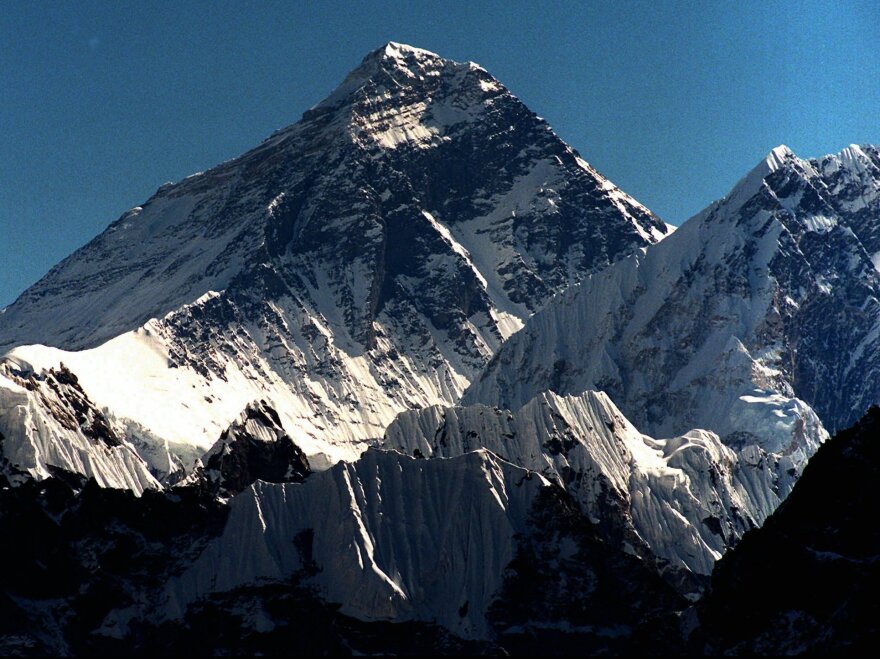Friday's tragedy on Mount Everest in which at least 13 Sherpa guides were killed in an avalanche has led others among that group of Nepalese who lead foreigners up the world's tallest mountain to issue some demands — and threaten to boycott the soon-to-start climbing season if their requests aren't granted.
"Sunday's call to action comes as the Nepalese government mulls calling off the 2014 climbing season on the world's highest peak. According to the Himalayan Times, a total of 334 mountaineers have been issued permits to attempt to climb Everest this season. If the trips are canceled the Nepalese government is required to reimburse the permits, which cost approximately $10,000 each."
According to the BBC, "in a statement, the Sherpas demanded compensation [to families] higher than the $400 offered by the government, as well as higher insurance payments." They've given the government seven days to respond.
Time writes that "among the demands sent to Nepal's Ministry of Culture, Tourism and Civil Aviation, the group called on the state to provide 10 million Nepalese rupee ($103,600) each to families of the deceased and critically injured, along with initiatives to increase the overall support infrastructure for local guides working in the Himalayas."
The mean annual per capita household income in Nepal was about $430 in 2010-2011, according to the Nepalese government's latest data.
Sherpas who lead or assist expeditions on Everest, according to the BBC, earn on average about $5,000 per year — more than 10 times the mean per capita. "Sherpas often make 20-25 round trips to carry kit and supplies to advanced camps, exposing them to greater risk," the BBC adds.
The risks are indeed considerable. All Things Considered spoke Friday with Grayson Schaffer, a senior editor and writer for Outside magazine who last year wrote a piece headlined "The Disposable Man: A Western History of Sherpas on Everest."
He reported then that:
"According to the Himalayan Database, which keeps track of such things, 174 climbing Sherpas have died while working in the mountains in Nepal — 15 in the past decade on Everest alone. ... During that time, at least as many Sherpas were disabled by rockfall, frostbite, and altitude-related illnesses like stroke and edema. A Sherpa working above Base Camp on Everest is nearly 10 times more likely to die than a commercial fisherman — the profession the Centers for Disease Control and Prevention rates as the most dangerous nonmilitary job in the U.S. — and more than three and a half times as likely to perish than an infantryman during the first four years of the Iraq war. As a dice roll for someone paying to reach the summit, the dangers of climbing can perhaps be rationalized. But as a workplace safety statistic, 1.2 percent mortality is outrageous. There's no other service industry in the world that so frequently kills and maims its workers for the benefit of paying clients."
The Atlantic has looked at "who dies on Everest — and where, and why," and reports that:
"The Himalayan Database counts 608 'member' deaths and 224 'hired' deaths on mountains in Nepal, including Everest, between 1950 and 2009. Almost 50 percent of hired deaths were due to avalanches, while nearly 40 percent of member deaths were attributed to falls.
"These patterns have a lot to do with who does what, and where, on mountains like Everest. Sherpas spend much of their time establishing and supplying camps in avalanche-prone zones. Paying expedition members move through those zones as quickly and efficiently as possible to save their energy for summit bids, where the risk of avalanches is lower but the air is thin and falls are more likely to occur."
The Sherpas who died Friday — in what is the single deadliest day ever on Everest — were setting up ropes and making other preparations near a base camp around 20,000 feet above sea level. As of Monday, three other Sherpas were still missing and presumed dead.
Everest's peak is an estimated 29,035 feet above sea level.
Related. Discovery Channel Cancels Plan For "Everest Jump Live":
Extreme sport enthusiast Joby Ogwyn had planned to climb to the top and then jump from the summit in a wingsuit.
In a statement, Discovery said it was canceling the jump "in light of the overwhelming tragedy at Mount Everest and out of respect for the families of the fallen."
Copyright 2021 NPR. To see more, visit https://www.npr.org.



